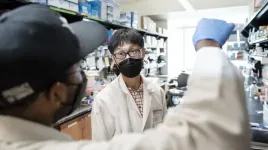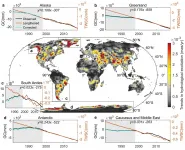Study reports novel role of enzyme in plant immunity and defense gene expression
2021-04-23
(Press-News.org) A recently published article in the Molecular Plant-Microbe Interactions journal provides new evidence that pathogens are hijacking the plant immune system to cause disease while providing insights into a newly discovered mechanism.
A large variety of pathogens infect plants and cause different diseases, which can lead to reduced crop yields. During infection, pathogens secrete effector proteins into the plant cell. Some of these proteins target plant proteasomal degradation machinery, which is responsible for recycling proteins to regulate cell processes. Some E1, E2 and E3-ligase proteins have been identified as playing a role in plant susceptibility or resistance to pathogen invasion. SALT- AND DROUGHT-INDUCED RING FINGER1 (SDIR1) is an E3-ligase that degrades regulators of the plant hormone abscisic acid (ABA) in response to drought stress.
Ramu Vemanna from the Regional Center for Biotechnology and colleagues at the Noble Research Institute reported a new way SDIR1 impacts plant immunity during pathogen-induced stress. They found that silencing SDIR1 reduced the growth of host-specialized and nonhost Pseudomonas syringae strains in the model plant Nicotiana benthamiana and disease symptom development in the model plant Arabidopsis thaliana. Overexpressing SDIR1 in A. thaliana allowed even the nonhost P. syringae strain to multiply and cause disease symptoms.
In contrast to these results from challenging plants with biotrophic bacterial pathogens, SDIR1 overexpression lines are resistant to the necrotrophic bacterial pathogen Erwinia carotovora. The SDIR1 overexpression plants showed higher levels of ABA and jasmonic acid (JA), a plant hormone involved in defense against necrotrophic pathogens. In response to host-specialized P. syringae strain DC3000, SDIR1 overexpression led to less expression of genes that repress JA-mediated defense (signaling genes JAZ7 and JAZ8). The interaction of SDIR1 with the JA pathway indicate it is a susceptibility gene for biotrophic pathogens like P. syringae yet involved in defense against necrotrophic pathogens like E. carotovora.
"These findings open up new research avenues to discover the SDIR1-associated mechanisms that can harness the crop improvement by altering different plant traits," Ramu said. "The SDIR1 is also a potential target for genome editing in order to enhance crop protection. If the structure of SDIR1 is solved, more opportunities evolve to design CRISPR targets and drug-like molecules to protect crops from pathogens and abiotic stresses."
INFORMATION:
For more information about this study, read END
ELSE PRESS RELEASES FROM THIS DATE:
2021-04-23
PHILADELPHIA, PA - The first National Institutes of Health (NIH) National Cancer Institute (NCI)-funded clinical study examining stereotactic body radiotherapy (SBRT) in the treatment of oligometastatic breast, prostate, and non-small cell lung (NSCLC) cancers displayed evidence that SBRT can be safely used to treat patients who have multiple metastases. These results were recently published in JAMA Oncology.
The results of the Phase I NRG-BR001 trial, conducted by the NCI National Clinical Trials Network group NRG Oncology, indicate that SBRT treatment in ...
2021-04-23
SAN FRANCISCO, CA--April 22, 2021--In their effort to understand the very earliest stages of life and how they can go wrong, scientists are confronted with ethical issues surrounding the use of human embryos. The use of animal embryos is also subject to restrictions rooted in ethical considerations. To overcome these limitations, scientists have been trying to recreate early embryos using stem cells.
One of the challenges in creating these so-called synthetic embryos is to generate all the cell types normally found in a young embryo before it implants into the wall of the uterus. Some of these cells eventually give rise to the placenta. Others become the amniotic sac in which the fetus grows. Both the placenta and the amniotic sac are crucial for the survival of the fetus, and defects ...
2021-04-23
A new research paper examining the relationship between the Omega-3 Index and risk for death from any and all causes has been published in END ...
2021-04-23
The extended Baryon Oscillation Spectroscopic Survey (eBOSS) collaboration has released its latest scientific results. These results include two studies on dark energy led by Prof. ZHAO Gongbo and Prof. WANG Yuting, respectively, from National Astronomical Observatories of the Chinese Academy of Sciences(NAOC).
The study led by Prof. Zhao was recently published in Monthly Notices of the Royal Astronomical Society.
Based on eBOSS observations, Prof. ZHAO's team measured the history of cosmic expansion and structure growth in a huge volume of the past universe, corresponding to a distance range between 0.7 and 1.8 billion light years away from us. This volume had never been ...
2021-04-23
A joint research study by the Pacific Water Research Centre at Simon Fraser University and the Fraser Basin Council points to the use of certified, nature-based solutions for protecting salmon and aquatic habitats in the Lower Mainland.
Salmon face various threats in the Lower Fraser Watershed (where the Fraser River passes through the Metro Vancouver geographical area), including habitat loss due to urban development and toxic stormwater runoff, which is projected to worsen due to climate change-driven extreme rain events.
The END ...
2021-04-23
Like tree rings, cave stalagmites are a portal to a prehistoric Earth, and now scientists from UNSW Sydney have found they are consistently reliable as time trackers the world over.
In a global investigation into the growth properties of stalagmites distributed across the world, the scientists found that while growth fluctuations due to climate events are evident in the shorter period, stalagmite growth over the longer periods - tens of thousands of years - are surprisingly linear.
"Our new global analysis shows that we can consider stalagmite growth as being like a metronome and very ...
2021-04-23
WASHINGTON-- Glacial melting due to global warming is likely the cause of a shift in the movement of the poles that occurred in the 1990s.
The locations of the North and South poles aren't static, unchanging spots on our planet. The axis Earth spins around--or more specifically the surface that invisible line emerges from--is always moving due to processes scientists don't completely understand. The way water is distributed on Earth's surface is one factor that drives the drift.
Melting glaciers redistributed enough water to cause the direction of polar wander to turn and accelerate eastward during the mid-1990s, according to a new study in Geophysical Research Letters, AGU's journal for high-impact, ...
2021-04-23
CHAMPAIGN, Ill. -- Attempts at restricting people's mobility to control the spread of COVID-19 may be effective only for a short period, researchers said. A new study examines people's mobility for seven months during the pandemic in the United States using publicly available, anonymized mobile phone data.
Reported in the Journal of Transport Geography, the study alerts authorities to the need for more manageable travel restrictions and policies that reduce COVID-19 exposure risk to essential workers - who, because they are required to be physically present at their workplaces, remained highly mobile during the pandemic.
The longitudinal study is one of the first to compare mobility data using a broad ...
2021-04-23
Being unable to walk quickly can be frustrating and problematic, but it is a common issue, especially as people age. Noting the pervasiveness of slower-than-desired walking, engineers at Stanford University have tested how well a prototype exoskeleton system they have developed - which attaches around the shin and into a running shoe - increased the self-selected walking speed of people in an experimental setting.
The exoskeleton is externally powered by motors and controlled by an algorithm. When the researchers optimized it for speed, participants walked, on average, 42 percent faster than when they were wearing normal shoes and no exoskeleton. The results of this study were ...
2021-04-23
Young scientists of Tomsk Polytechnic University as a part of the team of Arctic researchers have studied pore waters in three areas of methane release on the surface. They first managed to define in details the composition of pore waters in the cold methane seeps of the Eastern Arctic seas. The research findings are published in the Water academic journal.
The research was based on the samples obtained during the Arctic expedition aboard the research vessel "Akademik Mstislav Keldysh" in 2019. The scientists and students from 12 scientific institutions, including Tomsk Polytechnic University, Moscow Institute of Physics and Technology, Lomonosov Moscow State University, the Research Center of Biotechnology ...
LAST 30 PRESS RELEASES:
[Press-News.org] Study reports novel role of enzyme in plant immunity and defense gene expression




